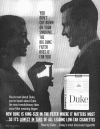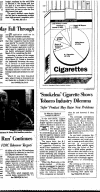Out of the ashes: the life, death, and rebirth of the "safer" cigarette in the United States
- PMID: 14759927
- PMCID: PMC1448228
- DOI: 10.2105/ajph.94.2.192
Out of the ashes: the life, death, and rebirth of the "safer" cigarette in the United States
Abstract
From 1964 through the early 1980s, both federal and voluntary agencies endorsed the concept of "safer" cigarettes. Beginning in the mid-1980s, several factors, including revelations of tobacco industry malfeasance, the development of nicotine replacement therapy, and the reconceptualization of smoking as a chronic disease, led to "safer" cigarettes being discredited. In the past few years, some public health professionals have begun to reconsider the viability of developing such products. The issue before us is stark: will a commitment to limiting the toll exacted by smoking preclude the tolerance of a product that while not safe may possibly be safer?
Figures



Comment in
-
Tobacco harm reduction involves more than cigarette harm reduction.Am J Public Health. 2004 Aug;94(8):1294; author reply 1294-5. doi: 10.2105/ajph.94.8.1294. Am J Public Health. 2004. PMID: 15284026 Free PMC article. Review. No abstract available.
References
-
- Institute of Medicine, Clearing the Smoke: Assessing the Science Base for Tobacco Harm Reduction, ed. Kathleen Stratton, Padma Shetty, Robert Wallace, and Stuart Bondurant (Washington, DC: National Academy Press, 2001). - PubMed
-
- Kenneth E. Warner and John Slade, “Low Tar, High Toll,” American Journal of Public Health 82 (1992): 17–18; Kenneth E. Warner, “Reducing Harm to Smokers: Methods, Their Effectiveness, and the Role of Policy,” in Regulating Tobacco, ed. Robert L. Rabin and Stephen D. Sugarman (New York: Oxford University Press, 2001), 111–142. - PubMed
-
- “Introduction: The Search for Harm Reduction,” in Harm Reduction: A New Direction for Drug Policies and Programs, ed. Patricia G. Erickson, Diane M. Riley, Yuet W. Cheng, and Pat A. O’Hare (Toronto: University of Toronto Press, 1997), 3–14.
-
- Kenneth E. Warner, John Slade, and David T. Sweanor, “The Emerging Market for Long-Term Nicotine Maintenance,” Journal of the American Medical Association 278 (1997): 1087–1092; Stanton A. Glantz, John Slade, Lisa A. Bero, Peter Hanauer, and Deborah E. Barnes, The Cigarette Papers (Berkeley: University of California Press, 1996), 90–91, 360–362; G. H. Miller, “The ‘Less Hazardous’ Cigarette: A Deadly Delusion,” New York State Journal of Medicine 85 (1985): 313–317. - PubMed
-
- Miller, “The ‘Less Hazardous’ Cigarette,” 313; Jacob Sullum, For Your Own Good: The Anti-Smoking Crusade and the Tyranny of Public Health (New York: The Free Press, 1998), 68; Doug Levy, “More Ad Leeway Considered for ‘Safer’ Cigarettes,” USA Today, 28May1997.
Publication types
MeSH terms
Substances
LinkOut - more resources
Full Text Sources
Miscellaneous

